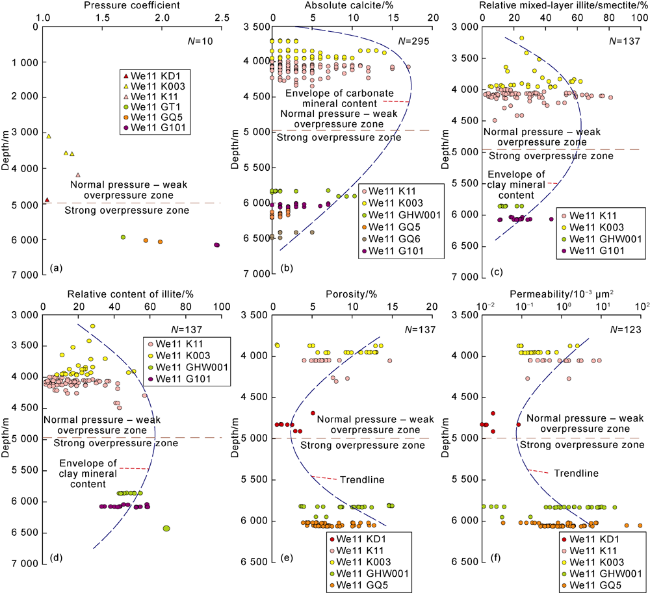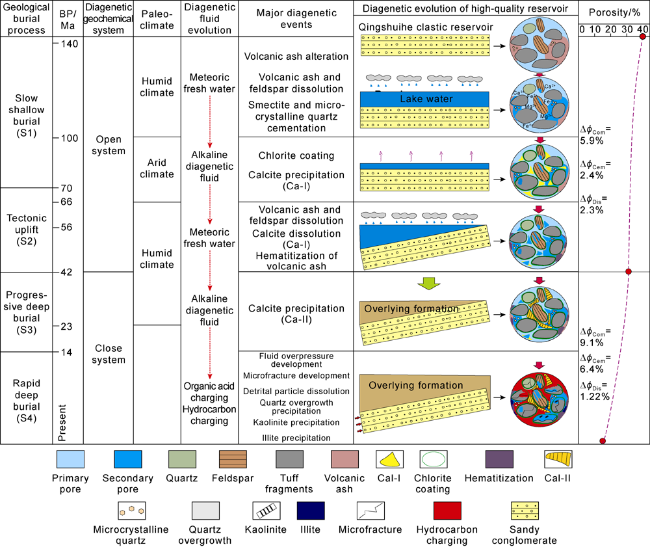Introduction
1. Geological setting
Fig. 1. Geographic location and stratigraphic column of Sikeshu Sag on the southern margin of the Junggar Basin. (a) geographic location of Sikeshu Sag; (b) Well locations in Gaoquan area; and (c) Stratigraphic column of Jurassic-Lower Cretaceous strata. |
Fig. 2. Burial and thermal history of the Qingshuihe Formation in Gaoquan area, Sikeshu Sag, southern margin of the Junggar Basin (modified from the Reference [9]). Q-Quaternary; N2d-Dushanzi Formation; N1t-Taxihe Formation; N1s- Shawan Formation; E2-3a-Anjihaihe Formation; K2d-Donggou Formation; K1h-Hutubi Formation; K1q-Qingshuihe Formation. |
Fig. 3. Pressure evolutionary history of the Qingshuihe Formation in Gaoquan area, Sikeshu Sag, southern margin of the Junggar Basin (modified from the Reference [10]). (a) Pressure evolutionary history in Well GQ5; (b) Pressure evolutionary history in Well G101. |
2. Samples and methods
3. Deep and ultra-deep clastic reservoirs
3.1. Petrological characteristics
Fig. 4. Sandstone composition of the Qingshuihe Formation in Gaoquan area, Sikeshu Sag, southern margin of the Junggar Basin. (a) Detrital composition and proportion; (b) Ternary diagram of rock composition; (c) Interstitial matter component and proportion. |
Fig. 5. Diagenetic minerals in clastic reservoirs of Qingshuihe Formation, Gaoquan area, Sikeshu Sag, southern margin of the Junggar Basin. (a) Intergranular volcanic ash, Well GHW001, 5 828.67 m, SEM; (b) Microcrystalline quartz in volcanic ash, Well GHW001, 5833.96 m, plane-polarized light; (c) Quartz overgrowth, Well GHW001, 5 829.77 m, SEM; (d) First-phase calcite in volcanic ash, Well GHW001, 5 833.96 m, SEM; (e) Second-phase calcite in primary pores, Well GHW001, 5 825.00 m, cross-polarized light; (f) Pyrite with metallic lustre, Well GHW001, 5 829.77 m, cross-polarized light; (g) Hematite in brick red, Well G101, 6081.96 m, plane-polarized light; (h) interparticle illite, Well GHW001, 5 824.19 m, SEM; (i) Honeycomb I/S, Well GHW001, 5832.84 m; SEM; (j) Chloritized volcanic ash, Well GHW001, 5 825.19 m, plane-polarized light; (k) Chlorite on particle edges, Well GQ5, 6 051.96 m, plane-polarized light; (l) Worm-like kaolinite in microfractures, Well GQ5, 6 051.96 m, SEM; (m) Kaolinite in intragranular dissolution pores, Well GHW001, 5 832.84 m, SEM. Qo-authigenic quartz; Qm-microcrystalline quartz; Ca-I-first-phase calcite; Ca-II-second-phase calcite; Py-pyrite; Ht-hematite; I/S-mixed-layer illite/smectite layer; I-illite; K-kaolinite; Ch-chlorite; FD-feldspar dissolution. |
3.2. Diagenetic mineral characteristics
3.2.1. Siliceous cements
3.2.2. Carbonate cements
3.2.3. Ferruginous cements
3.2.4. Autogenous clay cements
3.2.5. Dissolution characteristics
Fig. 6. Reservoir space of clastic reservoirs in Qingshuihe Formation, Gaoquan area, Sikeshu Sag, southern margin of the Junggar Basin. (a) Open microfractures, Well G101, 6 022.65 m, SEM; (b) Microfractures around intragranular dissolution pores, Well G101, 6 020.83 m, plane-polarized light; (c) Filamentous volcanic ash remnants, Well GHW001, 5 829.04 m, plane-polarized light; (d) Branched volcanic ash remnants, Well GHW001, 5 829.04 m, plane-polarized light; (e) Dissolved calcite in volcanic ash, Well GHW001, 5 828.67 m, plane-polarized light; (f) Dissolved calcite in volcanic ash, Well GHW001, 5833.96 m, plane-polarized light; (g) Regular primary pores, Well GHW001, 5 828.67 m, plane-polarized light; (h) Chlorite on particle edges, Well GQ5, 6 051.96 m, plane-polarized light. Ch-chlorite; Ca-I ds-first-phase calcite dissolution. Mf-microfracture; PP-primary pore; Tf-tuffaceous fragments dissolution. |
Fig. 7. Reservoir space of clastic reservoirs in Qingshuihe Formation, Gaoquan area, Sikeshu Sag, southern margin of the Junggar Basin (N represents sample number). (a) Distribution of primary pores, secondary pores and microfractures; (b) Distribution of intergranular and intragranular dissolution pores; (c) Distribution of porosity and permeability. |
3.3. Reservoir physical properties
3.4. Geochemical characteristics of diagenetic fluids in reservoirs
3.4.1. Geochemical characteristics of formation water
Fig. 8. Geochemical characteristics of formation water in Qingshuihe Formation, Gaoquan area, Sikeshu Sag, southern margin of the Junggar Basin. (a) Variation of metamorphic coefficient with burial depth; (b) Variation of desulphurization coefficient with burial depth. |
3.4.2. Fluid inclusions
Fig. 9. Petrographic characteristics and homogenization temperature distribution of the fluid inclusions of clastic rock reservoirs of Qingshuihe Formation in the Gaoquan area of Sikeshu Sag, southern margin of Junggar Basin. (a) Well GHW001, 5 828.19 m, aqueous inclusions in the microfracture of detrital quartz, plane-polarized light; (b) Well GHW001, 5 828.67 m, aqueous inclusions associated with gas hydrocarbon inclusions in the quartz overgrowth, plane-polarized light; (c) Well GHW001, 5 828.60 m, gas hydrocarbon inclusions in the quartz overgrowth, fluorescence; (d) Aqueous inclusions in microfractures; (e) Aqueous inclusions in quartz overgrowths. Al-aqueous inclusion; GHI-gas hydrocarbon inclusion. |
4. Discussion
4.1. Impact of the process of “long-term shallow burial and late rapid deep burial” on the diagenesis of deep and ultra-deep clastic rocks
4.1.1. Impact of burial process on compaction
Fig. 10. Comparison of the mechanical compaction intensities of clastic reservoirs of Qingshuihe Formation in different areas in southern margin of the Junggar Basin. (a) Western Gaoquan area; (b) Middle area. |
4.1.2. Impact of burial process on cementation and dissolution
Fig. 11. Geochemical elements of the diagenetic minerals and volcanic ash in clastic reservoirs of Qingshuihe Formation, Sikeshu Sag, southern margin of the Junggar Basin. |
Fig. 12. Stable isotopic compositions and precipitation temperature characteristics of different kinds of calcite of clastic rock reservoirs of Qingshuihe Formation in the Sikeshu Sag, southern margin of Junggar Basin. (a) Stable isotope characteristics of calcite; (b) Precipitation temperature characteristics of calcite. |
4.1.2.1. Siliceous cementation
4.1.2.2. Carbonate cementation
4.1.2.3. Autogenous clay cementation
4.2. Impact of “long-term shallow burial and late rapidly deep burial” on the development of high-quality deep and ultra-deep clastic reservoirs
Fig. 13. Relationship between chlorite content and reservoir quality of clastic rock reservoirs of Qingshuihe Formation in the Sikeshu Sag, southern margin of Junggar Basin. |
Fig. 14. Vertical distribution of pressure coefficient, calcite, porosity, permeability and clay minerals of clastic reservoirs in Qingshuihe Formation, Sikeshu Sag, southern margin of the Junggar Basin. (a) Pressure coefficient; (b) Calcite content; (c) Mixed-layer illite/smectite relative content; (d) Illite relative content; (e) Porosity; (f) Permeability. |
Fig. 15. The evolution history of high-quality deep and ultra-deep clastic reservoirs of Qingshuihe Formation, Sikeshu Sag, southern margin of the Junggar Basin. ΔϕCom—porosity loss caused by mechanical compaction; ΔϕCem—porosity loss caused by cementation; ΔϕDis—porosity increase caused by dissolution. |
















